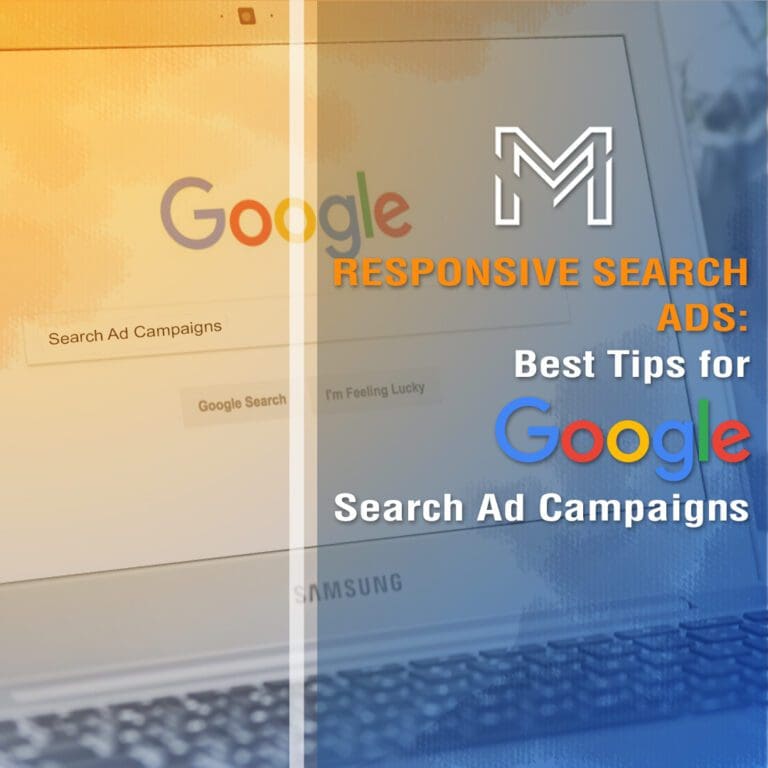Responsive search ads allow marketers to add various headlines and descriptions to their PPC google ads.
A responsive search ad (Google Ad) will allow its creators to add fifteen titles and four descriptions simultaneously in one Ad.
Responsive search ads are now a default format of Google PPC ad campaigns to accommodate the automation to make search ads more productive.
Search engine’s AI (machine learning systems) chooses the best combination that combines the titles and description to create unique search ads for different types of users.
This is a deliberate way to upgrade your Google PPC ads (pay per click) in which Google applies different sets of headlines and descriptions to see which ones are the most effective.
Search ads that respond to user input allow advertisers to create ads closely aligned with your prospective customers’ searches. Be aware that you can choose specific settings that dictate how Google examines your ads.
Benefits of Responsive Search Ads
Responsive search ads benefits include:
- Mobile Ads Optimization: Design ads flexible enough to adjust to the width of devices, allowing you to have more room to present your message to prospective customers.
- Save Your A/B Testing Time: You may save time by giving numerous headlines and descriptions as input for testing various ad versions at the same time. Google Ads will take charge to present the most appropriate combinations to your potential clients on the web.
- Targeting Geo Locations: You can customize your titles and description according to your clients’ locations or places of their particular interest.
- Maximize Your Reach: With the increase in the number of combinations of targeted keywords, you can target a wide range of customers to your product/service. It gives your advertisements the chance to participate in more auctions and match with more users’ searches.
- Increases CTR: Enhance the performance of your ads by increasing the number of clicks and conversions that your current text ads haven’t been capturing. Responsive search ads can help you be competitive in auctions.
How do Responsive Ads (Google PPC Search Campaign) Work?
One of the main complaints of Google advertisers was that the majority of ads on the platform were not dynamic.
After your advertisement was in the air, you were unable to alter the ad even when it wasn’t as efficient the way you intended it to be.
But, with the ability to create responsive ads for search, you can include four titles and fifteen descriptions to a single search advertisement.
Just imagine the permutation for four and fifteen is 32,670!
As you add more titles and descriptions in your ad, the more chances Google Ads has to choose from, the more in line with the potential customers’ searches. Google Ads assembles the text into various ad combos to prevent redundant content.
In an ad, only three headlines and two descriptions will be displayed in various combinations and order. In time, Google Ads will test the most effective ad combinations.
Google PPC ads are ideal for those who don’t have much time to play around with or track the Key Performance Indicators (KPI).
Responsive Search Ads are primarily helpful for brand awareness as well as lead generation.
For instance, an online store’s “product” page doesn’t have much content to rank on search engines based on their on-page SEO.
But Google does not look at the content of the page while displaying ads. It is wholly based on the pay per click ads optimization.
It’s your responsibility to ensure that your ads are appropriate to the page’s content since Google will substitute your headers and titles with those that you supply, trying to determine the best combination.
How to Create Responsive Search Ads?
After you log in to your Google PPC Ads account, follow these steps to compile a Responsive Search Ad:
- From the menu on the left side of the page, you can select ads and extensions.
- Click the plus icon that is displayed and select the responsive search ad.
- Input the URL on the top. It is the absolute path to the landing page of the ad. When you enter the URL, a preview of your advertisement will be displayed on the right.
- Now you can add your headlines. We will suggest entering all fifteen possible headers (combinations) but not redundancies! You’ll have to type in at least 3 headlines, and you’re able to add as many as 15.
- Enter the description for the ad. You’ll need to type at least two descriptions. However, you may write up to four.
- Click Save.
You can finish creating the ad quickly by following the six easy steps. But to run an effective Google PPC Ad Campaign, it is essential to follow some principles to make your Responsive Ad stand out.
Best Practices to Improve Responsive Search Ads Performance
Creating a search Ad campaign is all about creativity!
The logic behind successful campaigns is simple- Use all the available resources and compile them in mindful CTAs to attract the right customers to your place.
Five best practices can help your responsive search ads create an exemplary impact on your target audience for clicking onto the ad, thus increasing the conversion rate.
- Fill all the Fields While Customizing Ads
Responsive search ads (RSA) are a big hit in incorporating an abundance of information in one ad.
One must use this opportunity. Therefore, you must complete all of the descriptions and headlines asked by Google to get your ad working to its full potential.
It is suggested to use at least three distinct descriptions and ten headlines to allow the ads to work with maximum efficiency.
- Add the Headings and Descriptions that are Relatable
It is suggestive of guiding the search engine precisely to your ad’s purpose.
The distinctive feature of the Google AI algorithm can generate various variations based upon the interests of the users.
If you are filling all the required fields while creating Responsive Search Ads (RSA) but are inserting messages that aren’t unique, it could confuse the reader when the headlines are mixed up.
In other words, redundancy is to be avoided as much as possible since it hinders the software’s capacity to arrange advertisements and convey the right message.
You could follow some easy to get tips for formatting your headings (30 characters) and descriptions (90 characters), such as:
- Write at least five headlines that stand out from the rest. Please don’t duplicate the exact words because it will limit the number of ads created from the machine’s algorithm.
- Include your targeted keyword in 2 headlines (at least). Also, add headlines that don’t have a keyword. This combination will help Google to generate more variety of ad copy.
- Add 2 unique descriptions from your side (minimum). They must be in line with your product and must highlight the sought-after information by the user. You may add four descriptions.
- Pin Headlines and Descriptions Precisely
Responsive Search Ads, by default, will display the headline and description in any sequence.
There is a solution to this randomization. It is possible to pin headlines as well as descriptions to specific positions in the advertisement. Pins are a brand new idea used in responsive search ads.
But also, Google doesn’t advise pinning for all advertisers because it reduces the number of ads combinations linked to customers’ search queries on search engines and could affect the performance of ads.
Pin headlines and descriptions precisely where you can predict search volume and CTR. Following points to consider when opting for pinning:
- If you want any text to be always displayed in your ads, you can add it and pin it to headline position 1 or 2. You can also choose a description position 1. The text will always appear in the advertisement.
- You can attach headlines, descriptions, and other information disclaimers or special discounts.
- For a pin on an asset, you need to hover towards any description or headline right when creating the Ad and then click on the pin icon that appears. Select the location where you would like your headline and description to be displayed.
- Compare and test the effectiveness of RSA across all ad groups.
Responsive search advertisements come with many options for customization combined with Google’s machine-learning, the ads can be highly effective.
Since Expanded Text Ads (we can say the traditional format ads) are no longer the default ad format in Google PPC ads.
This is due to the machine-learning experience of RSA. The performance of these ads is advanced and innovative when compared with the traditional expanded text advertisements.
Sometimes there are instances when no optimal version of your advertisement could be produced, resulting in a decreased CTR. This could result in reduced performance at an early stage.
Therefore, it is highly recommended to test an RSA in each ad group in addition to regular ads.
This can provide the possibility of a variety in your advertising campaign. It also provides an excellent measure to evaluate the effectiveness of RSA.
After adding a few variants of headlines and messages, it is also crucial to include a call to action: CTA.
Different versions of CTAs can subscribe, call, read more about, etc., and determine which will work best for your paid search campaigns.
- Increase Ad Strength to Boost Performance
When you design a Responsive Search Ad, you’ll be able to see an indicator of ad strength on the right with a strength estimate.
The indicator of ad strength can help improve the effectiveness and quality of your advertisements to increase the performance of your ads.
Improving the ad’s strength by transforming it from “Incomplete” to ‘Excellent’ can lead to up to 9% more than average conversions and more clicks, as per Google.
Some facts about ad strength:
Ad strength measures the relevancy of the content, its diversity, and the high quality of Ad content.
A few of the advertising strengths suggestions:
- Fill all fields while customizing Responsive Search Ads.
- Include popular keywords in headlines and descriptions.
- Add headings and descriptions that are relatable.
- Reuse the content of your existing text ads. Don’t forget to add a straightforward CTA.
Try to earn at least a “Good” rating by changing the headlines’ content or descriptions or adding main keywords.
If you have lots of assets that are pinned to particular spots, you can try unpinning some of them to boost the strength of your ads.
Review the effectiveness of your Responsive Search Ads
You can see the progress of your ads from the metrics formed by Google by visiting on Ads and extensions page. You may get the complete report as you get in any other text ads.
- From the menu to the left, you can select ads and extensions.
- Choose the option to add a filter, appearing above the table of results.
- Within the menu which appears in the drop-down menu, select Attributes and then the type of advertisement.
- Click on the box: next to RSA.
- Choose the option to add a filter, appearing above the table of results. Click Apply.
- Download it.
Final Words: Best Practices for Responsive Search Ads
The idea of Responsive Search Ads is to make your paid search ad campaign automated and simpler.
Google’s AI (machine language) experiments between the titles and descriptions you entered for your ads.
The algorithm goes with the best combinations and works for promoting your ad to a large number of potential audiences.
Direct benefits of RSA are lead generation and optimization. And believe me, optimization isn’t a one-day process. Beginners can’t master PPC ads in their new ad sets. But they can be highly benefited from the latest default setting of Google ads.
If you are, to begin with, Google ads or don’t wish to spend most of your time searching keywords and optimizing your ads, then try using responsive search ads per ad set.
Start evaluating the hike in CTR and conversions!





